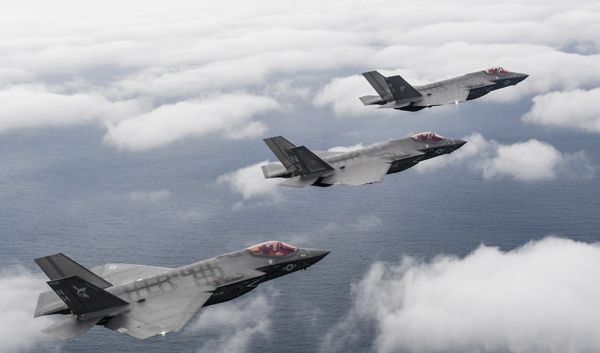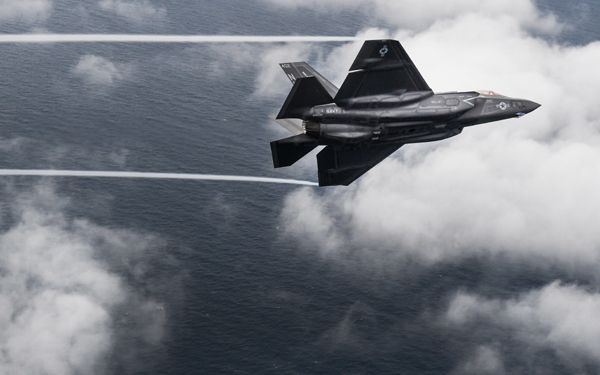
U.S. Navy photo by Chief Mass Communication Specialist Shannon E. Renfroe / Released
F-35C Achieves Initial Operational Capability (Press Release - February 28)
SAN DIEGO (NNS) -- The Commander, Naval Air Forces and the U.S. Marine Corps Deputy Commandant for Aviation jointly announced that the aircraft carrier variant of the Joint Strike Fighter, the F-35C Lightning II, met all requirements and achieved Initial Operational Capability (IOC).
The Feb. 28 announcement comes shortly after the Department of the Navy’s first F-35C squadron, Strike Fighter Squadron (VFA) 147, completed aircraft carrier qualifications aboard USS Carl Vinson (CVN 70) and received Safe-For-Flight Operations Certification.
In order to declare IOC, the first operational squadron must be properly manned, trained and equipped to conduct assigned missions in support of fleet operations. This includes having 10 Block 3F, F-35C aircraft, requisite spare parts, support equipment, tools, technical publications, training programs and a functional Autonomic Logistic Information System (ALIS).
Additionally, the ship that supports the first squadron must possess the proper infrastructure, qualifications and certifications. Lastly, the Joint Program Office, industry, and Naval Aviation must demonstrate that all procedures, processes and policies are in place to sustain operations.
“The F-35C is ready for operations, ready for combat and ready to win,” said Commander Naval Air Forces, Vice Admiral DeWolfe Miller. “We are adding an incredible weapon system into the arsenal of our Carrier Strike Groups that significantly enhances the capability of the joint force.”
Naval Air Station (NAS) Lemoore is the home-base for the Navy’s Joint Strike Fighter Wing, Navy F-35C fleet squadrons and the Fleet Replacement Squadron (FRS), VFA-125 that trains Navy and Marine Corps CVN-based Joint Strike Fighter pilots. To accommodate the F-35C program at NAS Lemoore, several facilities were built or remodeled to facilitate specific F-35C requirements with regard to maintenance and training, including a Pilot Fit Facility, Centralized Engine Repair Facility, Pilot Training Center and a newly-remodeled hangar. Future projects are planned as additional Navy squadrons transition into the F-35C. The Marine Corps plans to transition four F-35C squadrons that will be assigned to Carrier Air Wings for deployments.
“We’re very proud of what our Sailors have accomplished in the Joint Strike Fighter community,” said CAPT Max McCoy, commodore of the U.S. Navy’s Joint Strike Fighter Wing. “Their commitment to mission delivered fifth generation capability to the carrier air wing, making us more combat effective than ever before. We will continue to learn and improve ways to maintain and sustain F-35C as we prepare for first deployment. The addition of F-35C to existing Carrier Air Wing capability ensures that we can fight and win in contested battlespace now and well into the future.”
Meanwhile, Rear Admiral Dale Horan, director, USN F-35C Fleet Integration Office said, “The F-35C will revolutionize capability and operating concepts of aircraft carrier-based naval aviation using advanced technologies to find, fix and assess threats and, if necessary, track, target and engage them in all contested environments,” adding “This accomplishment represents years of hard work on the part of the F-35 Joint Program Office and Naval Aviation Enterprise. Our focus has now shifted to applying lessons learned from this process to future squadron transitions, and preparing VFA-147 for their first overseas deployment.”
The mission-ready F-35C is the latest addition to U.S. Navy’s Carrier Air Wing. With its stealth technology, state-of-the-art avionics, advanced sensors, weapons capacity and range, the aircraft carrier-based F-35C provides unprecedented air superiority, interdiction, suppression of enemy air defenses and close-air-support as well as advanced command and control functions through fused sensors. These state-of-the art capabilities provide pilots and combatant commanders unrivaled battlespace awareness and lethality. The F-35C is the final U.S. Joint Strike Fighter variant to declare IOC and follows the USAF’s F-35A and USMC’s F-35B. IOC declaration is a significant milestone.
Source: United States Navy
****

U.S. Navy photo by Chief Mass Communication Specialist Shannon E. Renfroe / Released

No comments:
Post a Comment